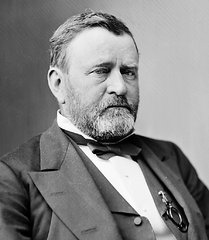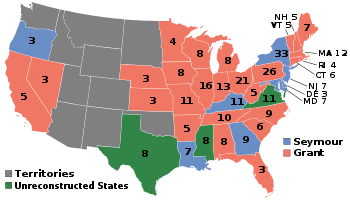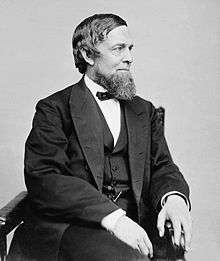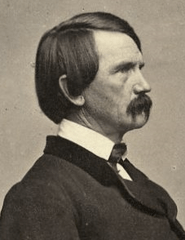United States presidential election, 1868
| | |||||||||||||||||||||||||||||||||||||||||||
| |||||||||||||||||||||||||||||||||||||||||||
| |||||||||||||||||||||||||||||||||||||||||||
|
| |||||||||||||||||||||||||||||||||||||||||||
| Presidential election results map. Red denotes states won by Grant/Colfax, blue denotes those won by Seymour/Blair, green denotes those states that had not yet been restored to the Union and which were therefore ineligible to vote. Numbers indicate the number of electoral votes allotted to each state. | |||||||||||||||||||||||||||||||||||||||||||
| |||||||||||||||||||||||||||||||||||||||||||
The United States presidential election of 1868 was the 21st quadrennial presidential election, held on Tuesday, November 3, 1868. It was the first presidential election to take place after the American Civil War, during the period referred to as Reconstruction. As three of the former Confederate states (Texas, Mississippi, and Virginia) were not yet restored to the Union, their electors could not vote in the election.
The incumbent President, Andrew Johnson, who succeeded to the presidency in 1865 following the assassination of President Abraham Lincoln, was unpopular and failed to receive the Democratic presidential nomination. By 1868, Johnson had alienated many of his constituents and had been impeached by Congress. Although Johnson kept his office, his presidency was crippled. After numerous ballots, the Democrats nominated former New York Governor Horatio Seymour to take on the Republican candidate, Civil War general Ulysses S. Grant. Grant was one of the most popular men in the North due to his efforts in concluding the Civil War successfully for the Union.
Although Seymour was buried in the electoral college, he gave Grant a good race for the popular vote. In addition to his appeal in the North, Grant benefited from votes among the newly enfranchised freedmen in the South, while the temporary political disfranchisement of many Southern whites helped Republican margins. It was the first election in which African Americans could vote in every Northern or Reconstructed Southern state, in accordance with the First Reconstruction Act. Every state except Florida used popular votes to determine electors for the Electoral College vote.
Background
Reconstruction and civil rights of former slaves was a hotly debated issue in the Union. Grant supported the Reconstruction plans of the Radical Republicans in Congress, which favored the 14th Amendment, with full citizenship and civil rights for freedpeople, including suffrage for adult freedmen. The Democratic platform condemned "Negro supremacy," and demanded a restoration of states’ rights, including the right of southern states to determine for themselves whether to allow suffrage for adult freedmen.
Nominations
Republican Party nomination
Republican candidate:
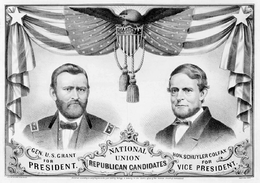

By 1868, the Republicans felt strong enough to drop the Union Party label, but wanted to nominate a popular hero for their presidential candidate. The Democratic Party controlled many large Northern states that had a great percentage of the electoral votes. General Ulysses S. Grant announced he was a Republican and was unanimously nominated on the first ballot as the party's standard bearer at the Republican convention in Chicago, Illinois, held on May 20–21, 1868. House Speaker Schuyler Colfax, a Radical Republican from Indiana, was nominated for vice-president on the sixth ballot, beating out the early favorite, Senator Benjamin Wade of Ohio.
The Republican platform supported black suffrage in the South as part of the passage to full citizenship for former slaves. It agreed to let northern states decide individually whether to enfranchise blacks. It opposed using greenbacks to redeem U.S. bonds, encouraged immigration, endorsed full rights for naturalized citizens, and favored Radical Reconstruction as distinct from the more lenient policy of President Andrew Johnson.[2]
Democratic Party nomination
Democratic candidates:

The Democratic National Convention was held in New York City between July 4, and July 9, 1868. The front-runner in the early balloting was George H. Pendleton, who led on the first 15 ballots, followed in varying order by incumbent president Andrew Johnson, Winfield Scott Hancock, Sanford Church, Asa Packer, Joel Parker, James E. English, James Rood Doolittle, and Thomas A. Hendricks. The unpopular Johnson, having narrowly survived impeachment, won 65 votes on the first ballot, less than one-third of the total necessary for nomination, and thus lost his bid for election as president in his own right.
Meanwhile, the convention chairman Horatio Seymour, former governor of New York, received 9 votes on the fourth ballot from the state of North Carolina. This unexpected move caused "loud and enthusiastic cheering," but Seymour refused, saying,
"I must not be nominated by this Convention, as I could not accept the nomination if tendered. My own inclination prompted me to decline at the outset; my honor compels me to do so now. It is impossible, consistently with my position, to allow my name to be mentioned in this Convention against my protest. The clerk will proceed with the call."[3]
After numerous indecisive ballots, the names of John T. Hoffman, Francis P. Blair, and Stephen Johnson Field were placed in nomination. None of these candidates, however, gained substantial support.
For twenty-one ballots, the opposing candidates battled it out: the East battling the West for control, the conservatives battling the radicals. The two leading candidates were determined that the other should not receive the nomination; because of the two-thirds rule of the convention, a compromise candidate was needed. Seymour still hoped it would be Chief Justice Salmon P. Chase, but on the twenty-second ballot, the chairman of the Ohio delegation announced, "at the unanimous request and demand of the delegation I place Horatio Seymour in nomination with twenty-one votes-against his inclination, but no longer against his honor."
Seymour had to wait for the rousing cheers to die down before he could address the delegates and decline.
"I have no terms in which to tell of my regret that my name has been brought before this convention. God knows that my life and all that I value most in life I would give for the good of my country, which I believe to be identified with that of the Democratic party..."
"Take the nomination, then!" cried someone from the floor.
"..but when I said that I could not be a candidate, I mean it! I could not receive the nomination without placing not only myself but the Democratic party in a false position. God bless you for your kindness to me, but your candidate I cannot be."[4]
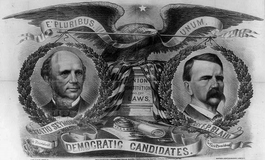
Seymour left the platform to cool off and rest. No sooner had he left the hall than the Ohio chairman cried that his delegation would not accept Seymour's declination; Utah's chairman rose to say that Seymour was the man they had to have. While Seymour was waiting in the vestibule, the convention nominated him unanimously.
Exhausted, the delegates unanimously nominated General Francis Preston Blair, Jr., for vice-president on the first ballot after John A. McClernand, Augustus C. Dodge, and Thomas Ewing, Jr., withdrew their names from consideration. Blair's nomination reflected a desire to balance the ticket east and west as well as north and south.[5]
Blair had worked hard to acquire the Democratic nomination and accepted second place on the ticket, finding himself in controversy.[6] Blair had gained attention by an inflammatory letter addressed to Colonel James O. Broadhead, dated a few days before the convention met. In his letter, Blair wrote that the "real and only issue in this contest was the overthrow of Reconstruction, as the radical Republicans had forced it in the South."[7]
General election
Campaign

The 1868 campaign of Horatio Seymour versus Ulysses S. Grant was conducted vigorously. The Republicans were fearful as late as October that they might be beaten.

Grant took no part in the campaign and made no promises. The Republican campaign theme—"Let us have peace," was taken from his letter of acceptance. After four years of civil war, three years of wrangling over Reconstruction, and the attempted impeachment of a president, the nation craved the peace Grant pledged to achieve.

Seymour answered none of the charges made against him, but made a few key speeches. Some newspapers exaggerated his faults. As governor, Seymour had sent troops to Gettysburg, but some press tried to portray him as disloyal to the Union. The New York Tribune led the cartoon campaign with the picture of Seymour standing on the steps of the City Hall calling a mob of New York draft rioters "my friends." The Hartford Post called him "almost as much of a corpse" as ex-President James Buchanan, who had just died. Additionally, Republicans alleged that insanity ran through the Seymour family, citing as evidence the suicide of his father.
Blair went on a national speaking tour in which he framed the contest with Ulysses S. Grant and the pro-Reconstruction Republicans in stark racial terms, warning of the rule of "a semi-barbarous race of blacks who are worshipers of fetishes and poligamists" and wanted to "subject the white women to their unbridled lust." Republicans advised Americans not to vote for Seymour, as Blair might succeed him.[8]
| Northern and Southern Democratic Sheet Music |
|---|
Blair had a reputation for being outspoken as a politician and his campaign speeches in 1868 attacked Radical Republicans.[9] Samuel J. Tilden, a member of the national committee, asked Blair to confine his campaigning to Missouri and Illinois for fear he "would hurt the ticket" because of his stand on Reconstruction.[10]
Seymour, who had not taken an active role in the campaign to this point, went into the canvass, seeking to steer the campaign away from the harshness of Blair's attacks on Radical Reconstruction. Seymour emphasized his idea that change in the South should be accomplished at the state level, without national interference. State civil authority should take precedence over military action. The president and the Supreme Court should be respected rather than attacked, as he claimed the Republicans had done. The Democrats would be careful to reorder national priorities.[11]
Results

Horatio Seymour polled 2,708,744 votes against 3,013,650 for Grant.
The closeness of the popular vote surprised the political elite at the time.[12] When Republican Representative James G. Blaine looked at the returns of the election, he thought that the slender popular majority for Grant was "a very startling fact."[13] Blaine, an acute judge of popular sentiment, was at a loss to explain the size of the Democratic vote.[14] Ethnic Irish Catholic and other immigrants had been settling in New York in number for nearly a quarter century. The very narrow margin by which Seymour lost several of the northern states like Indiana, Connecticut, and Pennsylvania, and the effects of new black votes in the South provoked the suspicion that a majority of the white men of the nation probably preferred him to Grant.[15]
The Democrats in the South had worked hard, but Republican regimes controlled the election machinery and carried all of the states there except Georgia and Louisiana.
Along the border, Kentucky, Maryland, and Delaware went overwhelmingly Democratic. No Democratic presidential candidate before or since has attained a higher percentage of the vote in the states of Kentucky and Maryland. As for Delaware, only the Democratic tickets of Johnson/Humphrey in 1964 (which was elected with the largest percentage of the popular vote since 1824) and Obama/Biden in 2008 (which had the first Delawarean on a national ticket) carried the state with a larger percentage of the vote.
Two border states, Missouri and West Virginia, both of which were under Republican control, gave their electoral votes to Grant. Seymour narrowly carried his home state of New York, but Blair, largely because of the Radicals' registry system, failed to carry Missouri. The Missouri Democrat exulted: "General Blair is beaten in his ward, his city, his county and his State."[16] In West Virginia, former Confederates were temporarily forbidden from voting or holding public office. It is estimated that 15,000 to 25,000 white residents were disfranchised as a result.[17]
Of the 1,708 counties making returns, Grant won in 991 (58.02%) while Seymour carried 713 (41.74%). Four counties (0.23%) split evenly between Grant and Seymour. Hence, the Democrats, even with all of the burdens of the war, still carried only 278 fewer counties than the triumphant Republicans. This was a solid party comeback at the grassroots level.

That Grant should lose New York to Seymour by a majority of 10,000 votes was a source of shame and anger to Republicans. Seymour's victory in New York was made the subject of a federal investigation. On November 4, Horace Greeley spoke at the Union League Club. The ULC promptly petitioned the Congress to look into the vote of the state. This petition was presented to the House of Representatives on December 14 and was accepted by a vote of 134-35 (52 abstained). Speaker of the House Schuyler Colfax, the Republican candidate for vice-president, appointed a committee of seven: five Republicans and two Democrats. The committee was most likely created because the Republicans could not lose New York without a protest. It reported to the House of Representatives on February 23, 1869.[18] The committee decided to take no action and Seymour retained all of New York's 33 electoral votes. Seymour was willing to return to this subject as long as he lived.[13]
In his 1943 book, writer Irving Stone, a novelist, suggested that if Seymour had carried all four of the October states (Pennsylvania, Ohio, Indiana, and Iowa), the Republican-controlled Congress would have acted to prevent the possibility of any Southern states supporting the Democratic ticket. Stone claimed that the only way the Democrats could have won was if they carried every close state in the North while retaining both Georgia and Louisiana. The vote of Georgia was contested at the electoral count, and it likely would have been disallowed if a Democratic victory had been decisive.
According to Seymour's biographer, Stewart Mitchell, the Republican Party claimed credit for saving the Union and was bound, bent, and determined to continue to rule it.[19]
| Presidential candidate | Party | Home state | Popular vote(a) | Electoral vote(a) |
Running mate | |||
|---|---|---|---|---|---|---|---|---|
| Count | Pct | Vice-presidential candidate | Home state | Elect. vote(a) | ||||
| Ulysses S. Grant | Republican | Illinois | 3,013,650 | 52.7% | 214 | Schuyler Colfax | Indiana | 214 |
| Horatio Seymour | Democratic | New York | 2,708,744 | 47.3% | 80 | Francis Preston Blair, Jr. | Missouri | 80 |
| Other | 46 | 0.0% | — | Other | — | |||
| Total | 5,722,440 | 100% | 294 | 294 | ||||
| Needed to win | 148 | 148 | ||||||
Source (Popular Vote): Leip, David. "1868 Presidential Election Results". Dave Leip's Atlas of U.S. Presidential Elections. Retrieved July 27, 2005. Source (Electoral Vote): "Electoral College Box Scores 1789–1996". National Archives and Records Administration. Retrieved July 31, 2005. (a) Mississippi, Texas, and Virginia did not participate in the election of 1868 due to Reconstruction. In Florida, the state legislature cast its electoral vote.
Geography of results
Cartographic gallery
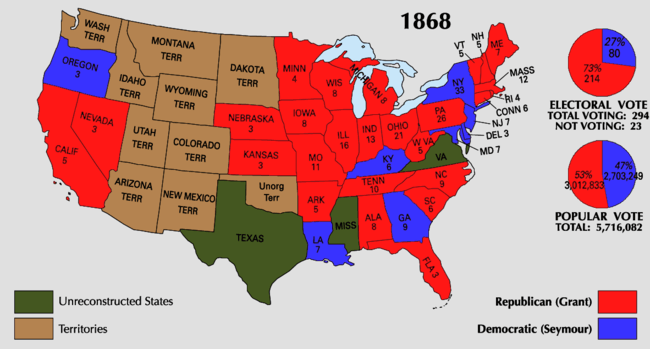
 Map of presidential election results by county.
Map of presidential election results by county. Map of Republican presidential election results by county.
Map of Republican presidential election results by county. Map of Democratic presidential election results by county.
Map of Democratic presidential election results by county. Map of "other" presidential election results by county.
Map of "other" presidential election results by county. Cartogram of presidential election results by county.
Cartogram of presidential election results by county. Cartogram of Republican presidential election results by county.
Cartogram of Republican presidential election results by county.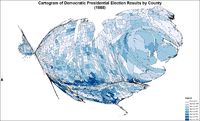 Cartogram of Democratic presidential election results by county.
Cartogram of Democratic presidential election results by county. Cartogram of "other" presidential election results by county.
Cartogram of "other" presidential election results by county.
Statistics
Counties with highest percent of vote (Republican)
- Hancock County, Tennessee 100.00%
- Monona County, Iowa 100.00%
- Ottawa County, Kansas 100.00%
- Jefferson County, Nebraska 100.00%
- McDowell County, West Virginia 100.00%
Counties with highest percent of vote (Democratic)
- St. Landry Parish, Louisiana 100.00%
- Lafayette Parish, Louisiana 100.00%
- Jackson Parish, Louisiana 100.00%
- De Soto Parish, Louisiana 100.00%
- Franklin Parish, Louisiana 100.00%
Counties with highest percent of vote (Other)
- DeKalb County, Alabama 0.70%
- Sullivan County, New Hampshire 0.11%
- Strafford County, New Hampshire 0.09%
- Carroll County, New Hampshire 0.02%
Close states
Red font color denotes states won by Republican Ulysses S. Grant; blue denotes those won by Democrat Horatio Seymour.
States where the margin of victory was under 5% (101 electoral votes)
- California 0.48%
- Oregon 0.74%
- New York 1.18%
- New Jersey 1.76%
- Alabama 2.50%
- Indiana 2.79%
- Connecticut 2.98%
- Pennsylvania 4.41%
See also
- American election campaigns in the 19th century
- First inauguration of Ulysses S. Grant
- History of the United States (1865–1918)
- History of the United States Democratic Party
- History of the United States Republican Party
- Reconstruction era of the United States
- Third Party System
- United States House elections, 1868
Footnotes
- ↑ "Voter Turnout in Presidential Elections". The American Presidency Project. UC Santa Barbara.
- ↑ William DeGregorio, The Complete Book of U.S. Presidents, Gramercy,d 1997
- ↑ Irving Stone (1943), They Also Ran: The Story of the Men Who Were Defeated for the Presidency, Garden City, New York: Doubleday and Doran, pg. 280
- ↑ Official proceedings of the National Democratic convention, held at New York, July 4-9, 1868 (Pg. 153)
- ↑ William E. Parrish (1998), Frank Blair: Lincoln's Conservative, Missouri Biography Series, University of Missouri Press, pg. 254
- ↑ Frank Blair: Lincoln's Conservative, William E. Parrish, pg. 260
- ↑ Stewart Mitchell, Horatio Seymour of New York, Harvard University Press, 1938, p. 448
- ↑ Stewart Mitchell, Horatio Seymour of New York, Harvard University Press, 1938, pg. 23
- ↑ Mitchell (1938), Horatio Seymour, pp. 448-449
- ↑ William E. Parrish, Frank Blair: Lincoln's Conservative, p. 255–256
- ↑ William E. Parrish, Frank Blair: Lincoln's Conservative, pg. 258–259
- ↑ Irving Stone (1943), They Also Ran, pg. 282
- 1 2 Stewart Mitchell, Horatio Seymour of New York, pg. 483
- ↑ Mitchell, Horatio Seymour of New York, pg. 443
- ↑ Mitchell, Horatio Seymour of New York, pg. 474
- ↑ Frank Blair: Lincoln's Conservative, William E. Parrish, pg. 259-260
- ↑ "A Brief History of African Americans in West Virginia," West Virginia Culture "Archived copy". Archived from the original on January 1, 1970. Retrieved December 7, 2015.
- ↑ Horatio Seymour of New York, Stewart Mitchell, pg. 474-475
- ↑ Horatio Seymour of New York, Stewart Mitchell, pg. 484
References
- American Annual Cyclopedia...1868 (1869), online, highly detailed compendium of facts and primary sources
- Gambill, Edward. Conservative Ordeal: Northern Democrats and Reconstruction, 1865-1868. (Iowa State University Press: 1981).
- Edward McPherson. The Political History of the United States of America During the Period of Reconstruction (1875) large collection of speeches and primary documents, 1865–1870, complete text online.[The copyright has expired.]
- Prymak, Andrew. "The 1868 and 1872 Elections," in Edward O. Frantz, ed. A Companion to the Reconstruction Presidents 1865-1881 (Wiley Blackwell Companions to American History) (2014) pp 235–56 online
- Rhodes, James G. History of the United States from the Compromise of 1850 to the McKinley-Bryan Campaign of 1896. Volume: 6. (1920). 1865-72; detailed narrative history
- Simpson, Brooks D. Let Us Have Peace: Ulysses S. Grant and the Politics of War and Reconstruction, 1861-1868 (1991).
- Summers, Mark Wahlgren.The Press Gang: Newspapers and Politics, 1865-1878 (1994)
- Summers, Mark Wahlgren. The Era of Good Stealings (1993), covers corruption 1868-1877
External links
| Wikimedia Commons has media related to United States presidential election, 1868. |
- Presidential Election of 1868: A Resource Guide from the Library of Congress
- 1868 popular vote by counties
- 1868 State-by-state Popular vote
- "How close were the US Presidential elections?" — Michael Sheppard, Massachusetts Institute of Technology, 2012
- Election of 1868 in Counting the Votes
